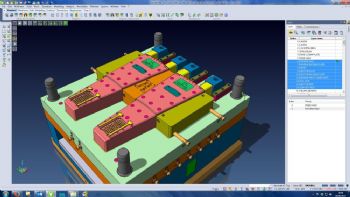
Anyone who voted in this year’s UK General Election or last year’s American Presidential election is likely to have slotted their paper into ballot boxes manufactured for the ‘government election solutions provider’ Pakflatt by Crossen Engineering Ltd.
Operating from a 22,000ft
2 facility in Belfast, 32-employee Crossen produces all its own tooling, ranging from aluminium alloy moulds for small- to medium-batch production through to fully hardened hot-runner mould tools for larger runs of 500,000 components — and more.
The company serves a variety of industries — including automotive, aerospace, medical, construction, household and materials handling — and ships up to 250,000 moulded parts a month. These are produced on Romi, Fanuc and Demag machines.
Contributing to Crossen’s success are its expertise in mould design, its use of VISI mould-and-die software (
www.visicadcam), and building strategic partnerships with its clients — assisting on project needs, from
initial design concept through to prototyping and production, according to individual budgets and timescales.
As well as the ballot booths and ballot boxes for the recent elections, other notable products include: components for the award-winning company Bloc Blinds; plastic mouldings for Resusannie’s medical CPR mannequins; release mechanisms used by Eurofighter pilots; interior solutions for Porsche; and helmets for the Irish national sport of hurling.
Bloc Blinds’ managing director, Cormac Diamond, says Crossen is now an integral part of the team, having established a strong and collaborative relationship over the last 10 years.
“Their superior technical expertise, ability to deliver within rigid lead times, and their service, have all helped Bloc to become a market leader in the manufacture and supply of innovative and award-winning window blinds.”
Fast turn-round
Business development manager Peter Crossen says the company likes to be included at the start of the design stage, and it is geared up for a quick turn-round of aluminium-alloy injection mould tools for low- to medium-volume production.

“Every mould we make is designed in VISI and manufactured on our range of three- and five-axis Hurco machining centres. Furthermore, we recently bought a Röders high-speed machining centre, mainly for the quick turn-round of complex mould inserts.”
The other side to the family-run operation is pressing; Crossen has 13 presses with capacities ranging from 50 to 500 tonnes, and all press tooling is also designed using VISI and manufactured in-house.
“We often work with companies that have an idea for a product but need assistance with design, a low-cost tooling option and rapid turn-round.
“We frequently find that a customer has a 3-D printed part and needs to start volume production. It can be costly for them to see a project through to fruition independently, but with VISI, we can quickly design inserts and produce a simple injection moulding tool in less than two weeks.
“We can also review a customer’s CAD file in VISI, then design the mould around that file, making adjustments to aspects such as wall thicknesses, part radii and draft angle.”
Optimised moulding
Managing director Paul Crossen says the company has used the VISI CAD module for several years but has only recently installed VISI Flow, which is now playing an increasingly important part in the production process.

“The ‘preventative analysis’ software optimises the tool design and moulding parameters by detecting a wide range of potential manufacturing issues — such as warpage, weld lines, air traps, filling issues and hot spots — while also determining the optimum size and position for gates and runners.
“This software gives us total confidence that the parts are achievable by allowing us to see potential problems. The cost of changing a mould to correct a preventable quality issue only adds up to wasted time and money.
“Customers are extremely impressed that we can accurately forecast these issues and back it up with facts from the flow simulation. All moulding variables and results are reported — and fed into a report that can be shown to the customer.
“When everything has been proved out, we will continue with the full mould design, importing the steel or aluminium and bill of materials directly into VISI. Then we will cut the cavities and add in the injection system.”
Paul Crossen says the company’s apprentices are trained in the use of VISI “at an early stage of their development, as it is something they will need to be highly proficient in throughout their careers”.
One of the third-year apprentices at Crossen says he makes extensive use of VISI for extracting electrode data and modifying parts for machining: “If I’m starting from scratch with 2-D data, I will import that into VISI and start to build the relevant geometry, but if I have a 3-D model, I’ll open that directly and make any necessary machining adjustments.”
He began using VISI in the first year of his apprenticeship and says his work would take considerably longer without it.
“This software is very powerful, and using it means we won’t manufacture a mould, only to find that it doesn’t perform as expected. By simulating the entire process in VISI, we can be sure that the mould is going to produce perfect plastic parts before we start cutting metal.”